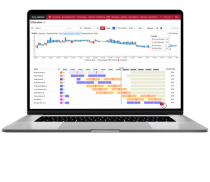- Products
- Solutions
Solutions
Services
- Resources
- Customers
Explore CSCCalabrio Success Center
Calabrio product training
- Partners
Contact Center ReportingFind More Great Content- Customer Interaction Analytics
- Workforce Management
- Customer Experience
- Quality Management
- Contact Center Reporting
- Managing a Remote Workforce
Home » Workforce Optimization » Contact Tracing Best Practices: Getting the Most Value from Your Data
Contact Tracing Best Practices: Getting the Most Value from Your Data
Doug Mancinelli, Strategic Consultant at Calabrio, walks through the COVID-related dashboards and terms within the Analytics suite. Watch the full webinar here.
With more governments and public sector organizations tracking the spread of COVID-19, the need for accurate contact tracing is essential. The core of analytics is trying to understand all the interactions that agents have with your customers. When conduct contact tracing efforts, this is especially important. Whether you are just trying to understand infection rates or highlighting specific trends in agent response, analytics can help clarify your strategy.
Tracking the right data for contact tracing
Staffing contact tracing centers is the first aspect of the operation that must be addressed. The Centers for Disease Control and Prevention (CDC) has recommended that states need 30 tracers for every 100,000 citizens. That tracer team will likely be made up of a hybrid force of health professionals, librarians and others who are skilled in sleuthing. But regardless of how a state or BPO chooses to staff the contact tracing center, it will need workforce management (WFM) software to forecast staffing needs and schedule the teams.
Guidance for the types of data to track and collect should come from the CDC. Focus particularly on case count changes:
- Any instances of daily case counts going up or down, especially in a particular area – like a facility, neighborhood.
- The CDC’s Contract Tracing manual can help further with specific strategies — depending on whether your contact tracing operation is symptom-based or exposure-based.
You’ll also need to make sure you’re asking the right questions — and receiving the right information — in evaluation forms during the tracing effort. With all questions in evaluation forms, you’ll need to identify if there is an error that impacts the person (infected person). This is why evaluation forms are structured to identify if it was a critical or procedural error. If it is a procedural error, that is an internal error and doesn’t affect patient care of treatment.
Collecting actionable data on agent interactions
What particular agent metrics should you focus on for contact tracing? Contact tracing is challenging because personal information must be gathered from each interaction, often from people who are distressed, rushed for time or mistrustful of providing such information. Quality management software can help tracing agents more empathetically and efficiently collect the required information, as evaluating tracer-patient interactions shows where and which tracers need coaching. Automated quality management, infused with predictive analytics, provides scoring and insights for 100% of interactions, which expedites targeted training by more efficiently highlighting areas for improvement. Advanced WFM tools can, in turn, be used to automatically schedule such training for tracers and help accelerate their development.
Some key metrics could be centered on responding and answering people who have been notified they have been in contact with someone with COVID.
- If some communication (text, voicemail) goes out, they can call an 800 number and no one responds — or they wait too long, they could hang up and potentially infect others.
- Make sure to track call abandonment rate, ASA, average time waiting or in queue.
To ensure HIPAA compliance, these soft skills listed on the CDC website should also be considered:
- An understanding of patient confidentiality, including the ability to conduct interviews without violating confidentiality (e.g., to those who might overhear their conversations)
- Understanding of the medical terms and principles of exposure, infection, infectious period, potentially infectious interactions, symptoms of disease, pre-symptomatic and asymptomatic infection
- Excellent and sensitive interpersonal, cultural sensitivity, and interviewing skills such that they can build and maintain trust with patients and contacts
- Basic skills of crisis counseling, and the ability to confidently refer patients and contacts for further care if needed
- Resourcefulness in locating patients and contacts who may be difficult to reach or reluctant to engage in conversation
- Understanding of when to refer individuals or situations to medical, social, or supervisory resources
- Cultural competency appropriate to the local community
Tracking these soft skills via analytics will really be helpful to dig into words and phrases — and from there, assign coaching opportunities. It also provides an opportunity for the agents to improve on their own.
Learn more about how Calabrio can help with your contact tracing efforts.
Brad Snedeker is the Director of Customer Advocacy at Calabrio. With over 15 years in the industry, Brad has extensive knowledge of the contact center space. As Calabrio’s head of the Innovation Center, he works directly with users to teach and develop new and innovative techniques to implement customer engagement and WFO best practices.Recent PostsDig Into More Great Content!
Calabrio is a trusted ally to leading brands. The digital foundation of a customer-centric contact center, the Calabrio ONE workforce performance suite helps enrich and understand human interactions, empowering your contact center as a brand guardian.
We maximize agent performance, exceed customer expectations, and boost workforce efficiency using connected data, AI-fueled analytics, automated workforce management and personalized coaching.
Only Calabrio ONE unites workforce optimization (WFO), agent engagement and business intelligence solutions into a true-cloud, fully integrated suite that adapts to your business.
For customers and partners.
© Copyright 2024 Calabrio, Inc.3 ways to embrace the evolving world of remote workThe New Era of Workforce Engagement Management Has Arrived: Announcing the New Calabrio ONESend this to a friend - Solutions













